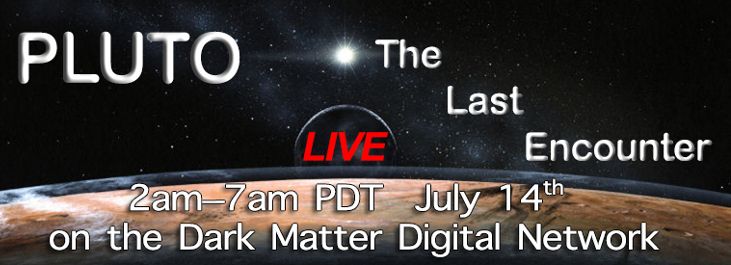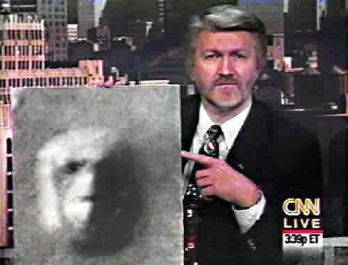Jupiter is king.
King is nice and all, but the queen is the star of our solar system:
Jupiter is king.
My favorite has always been Jupiter:

There has always been something oddly creepy about Jupiter for me
Set that shit to eerie music and it's even better.
Who remembers the Voyager 2 flyby of Uranus in 1986 and Neptune in 1989?


It's about that time again!
Monday, July 13th
11:15pm: Last image sent from NH before it goes dark.

Did they ever come up with a theory on why the great red spot goes on?
I always find it strange that real pictures of planets look so fake to me. I have no idea why I think like that.
It's probably because there is virtually nothing between the planet and the camera to obstruct the view. It's almost all light out there. It looks so clear out there in space.
That and planets are so large it's impossible to comprehend the scale of the object you're looking at.
The fact that we have captured Jupiter being struck by asteroids is just awesome. Shoemaker-Levy in '94 and then this doozie in 2012: http://www.youtube.com/watch?v=4Q5KXdvvvfQThis shit had to have been so cool for people of the time. The Voyagers were old news by the time I was old enough to appreciate them.
The fact that we have captured Jupiter being struck by asteroids is just awesome. Shoemaker-Levy in '94 and then this doozie in 2012: http://www.youtube.com/watch?v=4Q5KXdvvvfQ
Did they ever come up with a theory on why the great red spot goes on?
Actually, no. Diamonds are made through natural processes. Whereas chocolate is a man made material.
Earth sized asteroid? I don't believe there is any asteroid's in the solar system the size of Earth.....huge yes but no Earth sized unless I'm missing something?
I think if I remember correctly, the explosion was the size of the earth, not the asteroid itself.
Question, with the sun so far away, if we are near will planets appear as bright as the pictures to us or just really dark to the naked eye?
Man, that's crazy. And imagine the sheer size of it.Hexagonal storm on Saturn. Always thought that was pretty cool.
Voyager is old news, but the program has still been making weirdly relevant observations due to sheer location. Voyager 1 may be a relic of 1970s tech kept alive by a faltering chunk of plutonium, but it's a relic of 1970s tech that's way the hell out in the interstellar medium, and it's still talking to us.This shit had to have been so cool for people of the time. The Voyagers were old news by the time I was old enough to appreciate them.
https://www.youtube.com/watch?v=LXRrpdYlgrY
The issue is complicated by atmospheres not really being 2-spheres.There is! It's not even a theory. Even better. It's a theorem. A result from mathematics. And one of the best named theorems in all of mathematics. The Hairy Ball Theorem. "If you have a hairy ball and you try and comb it, you can never comb it flat."
In better terms, the Hairy Ball Theorem states that anytime you have wind blowing over a spherical surface, there exists at least one point where there is no wind blowing. That is, it's impossible for the wind to blow everywhere. It's possible for the air to be completely still everywhere, but if you allow any movement, you will inevitably get one point where there is no wind blowing. The point is the eye of a cyclone.
Now, the Hairy Ball Theorem doesn't state that Jupiter's big red spot must always exist as it does. Only that there will always be some cyclone going. So, I suppose, in truth, I'm not really answering your question precisely as you asked it, but I think this is an interesting result that's fun to share because it's a theorem from topology that has real world results in a very cool way.
It's so strange how pale and consistent this picture of Uranus is (har har, but really). It's like if you used the paint bucket to fill light blue on a planet. I realize they took better pictures later but it's so featureless.
http://www.planetary.org/blogs/emily-lakdawalla/2015/07131311-pluto-first-science.html
Looks like Pluto's diameter is bigger than they thought, making it bigger than Eris and therefore the biggest dwarf planet, or dare I say.. The smallest planet?
No.
So how possible is it that they are making mistakes about Eris` diameter and mass? In the article linked she makes it sound as if they have concrete data for Eris.
Screw the outer planets.
TERRESTRIAL PLANETS REPRESENT!
I remember coming home and seeing that on the news.
Amazing how much more we know since I've been alive.
I remember the Neptune flyby much more because I watched nights of live NASA coverage (you can find some on youtube).
https://www.youtube.com/watch?v=Y11CVuxfvPE
https://www.youtube.com/watch?v=BDbEvz-gr1Q
https://www.youtube.com/watch?v=y038-R3kwfw
Totally unrelated but this was the right around the time that Sega and NEC were launching the Genesis and TurboGrafx-16 in the U.S.
God damn, I miss Carl Sagan.I remember the Neptune flyby much more because I watched nights of live NASA coverage (you can find some on youtube).
https://www.youtube.com/watch?v=Y11CVuxfvPE
Screw the outer planets.
TERRESTRIAL PLANETS REPRESENT!

Imagine a VR setup with a solar system simulator, where kids could stand on Europa or fly past Jupiter. That's one of the most exciting aspects of VR to me, as an educational tool.
Who remembers the Voyager 2 flyby of Uranus in 1986 and Neptune in 1989?


It's about that time again!


Why would you put links to kooks like Hoagland and Art Bell in this thread?
Yes, it is.Is Io really that colorful or has an artist been having a bit too much fun with photoshop?
Yes, it is.
Planet is largely sulfur.
So we won't see anything until Wednesday or Thursday?
